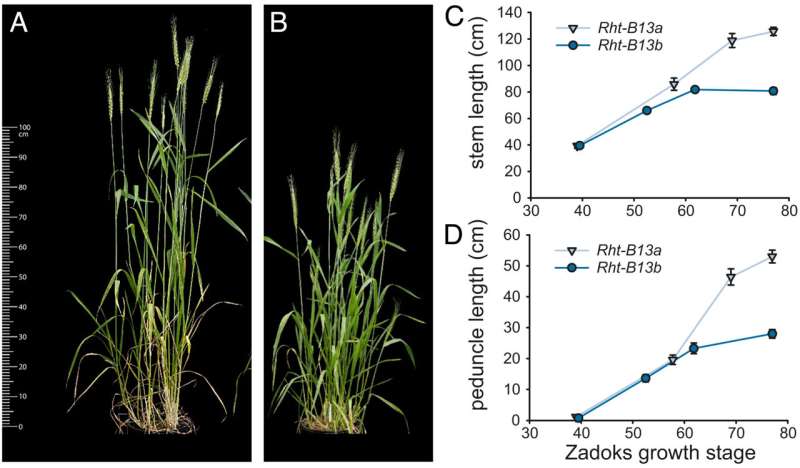New 'Green Revolution' gene discovery sows hope of drought resilient wheat

Reduced height, or semi-dwarf, wheat varieties with improved drought resilience may soon be grown in fields across the globe following an exciting scientific discovery.
Researchers at the John Innes Centre in collaboration with an international team of researchers have discovered a new height-reducing gene Rht13 which means that seeds can be planted deeper in the soil giving access to moisture, without the adverse effect on seedling emergence seen with existing wheat varieties.
Varieties of wheat with the Rht13 gene could be rapidly bred into wheat varieties to enable farmers to grow reduced-height wheat in drier soil conditions.
"We have found a new mechanism that can make reduced-height wheat varieties without some of the disadvantages associated with the conventional semi-dwarfing genes. The discovery of the gene, its effects and exact location on the wheat genome, means that we can give breeders a perfect genetic marker to allow them to breed more climate-resilient wheat," said John Innes Centre group leader Dr. Philippa Borrill corresponding author of the study.
The study, which appears in the Proceedings of the National Academy of Sciences (PNAS), suggests that additional agronomic benefits of the new semi-dwarfing gene may include stiffer stems, better able to withstand stormier weather.
Since the 1960s and the "Green Revolution," reduced height genes have increased global wheat yields because the short-stemmed wheat they produce puts more investment into the grains rather than into the stems and has improved standing ability.
However, the Green Revolution genes bred into wheat also have a significant disadvantage: when these varieties are planted deeper to access moisture in water limited environments, they can fail to reach the surface of the soil.
The newly discovered Rht13 dwarf gene overcomes this problem of seedling emergence because the gene acts in tissues higher up in the wheat stem. So, the dwarfing mechanism only takes effect once the seedling has fully emerged. This gives farmers a significant advantage when planting deeper in dry conditions.
The discovery of the Rht13 dwarfing gene was made possible by recent advances in wheat genomic research, principally the publication in 2020 of the Pan Genome, an atlas of 15 wheat genomes collected from around the world.
Earlier studies had identified the Rht13 locus—the region of DNA—as located on chromosome 7B on the wheat genome but the underlying gene had not been identified.
In collaboration with the group of Wolfgang Spielmeyer at CSIRO Australia, researchers used RNA and chromosome sequencing to track down the new semi-dwarfing gene.
They found a one–point mutation change—a single letter change in a sequence of DNA—and this variation on the Rht13 locus encodes an autoactive NB-LRR gene, a defense related gene, that is switched on all the time.
Experiments testing the effects of the gene in a range of transgenic wheat plants confirmed that the Rht13 variation represents a new class of reduced height gene—more commonly associated with disease resistance as opposed to widely used Green Revolution genes (Rht-B1b and Rht-D1b)) which are associated with hormones and therefore affect overall growth.
"This is an exciting discovery because it opens a new way to use these autoactive NB-LRR genes in breeding in agriculture." explains Dr. Borrill.
"In dry environments, the alternative reduced height gene will allow farmers to sow seeds at depth—and not have to gamble on the seedlings emerging. We think the stiffer stems could result in less lodging—where stems fall over—and the upregulation of a pathogen related dwarfing gene may help to enhance resistance response to certain pathogens."
The next step for this research will be to test how this gene works in diverse agronomic environments from the UK to Australia. The research team are also investigating how the mechanism works and are exploring the hypothesis that it may be down to molecular restrictions on the cell wall preventing elongation.
More information: Philippa Borrill et al, An autoactive NB-LRR gene causes Rht13 dwarfism in wheat, Proceedings of the National Academy of Sciences (2022). DOI: 10.1073/pnas.2209875119
Journal information: Proceedings of the National Academy of Sciences
Provided by John Innes Centre



















